

Matt Robinson
2026 Skoda Fabia 130 review: Quick drive
40 Minutes Ago
A $100,000, 12-seater Mercedes-Benz bus? Not many will need to ask the question, but the new Sprinter Transfer has plenty of answers.
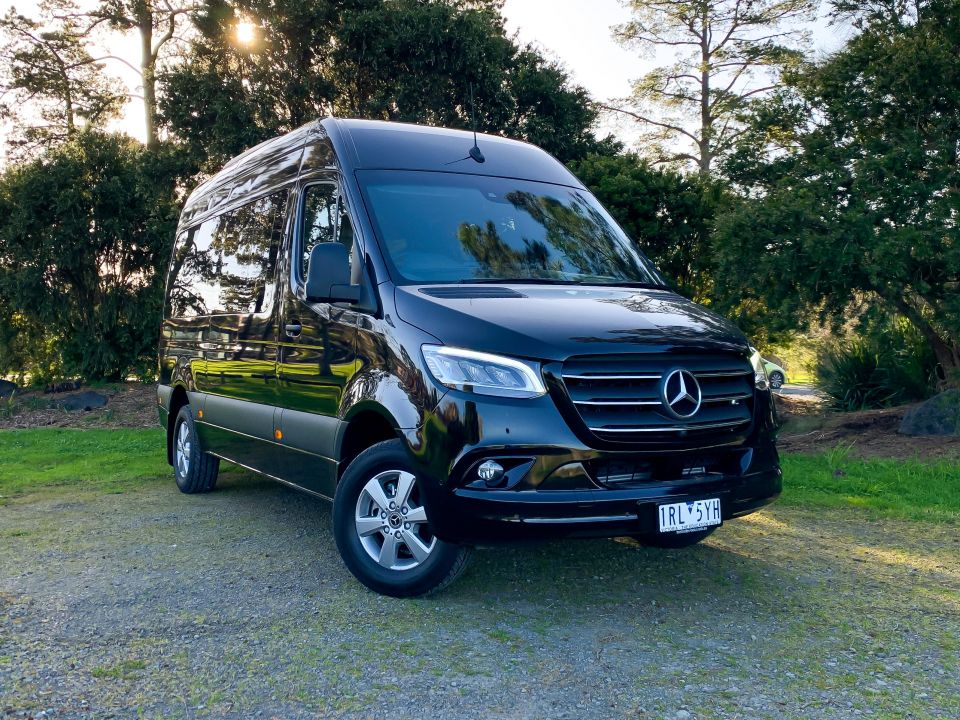
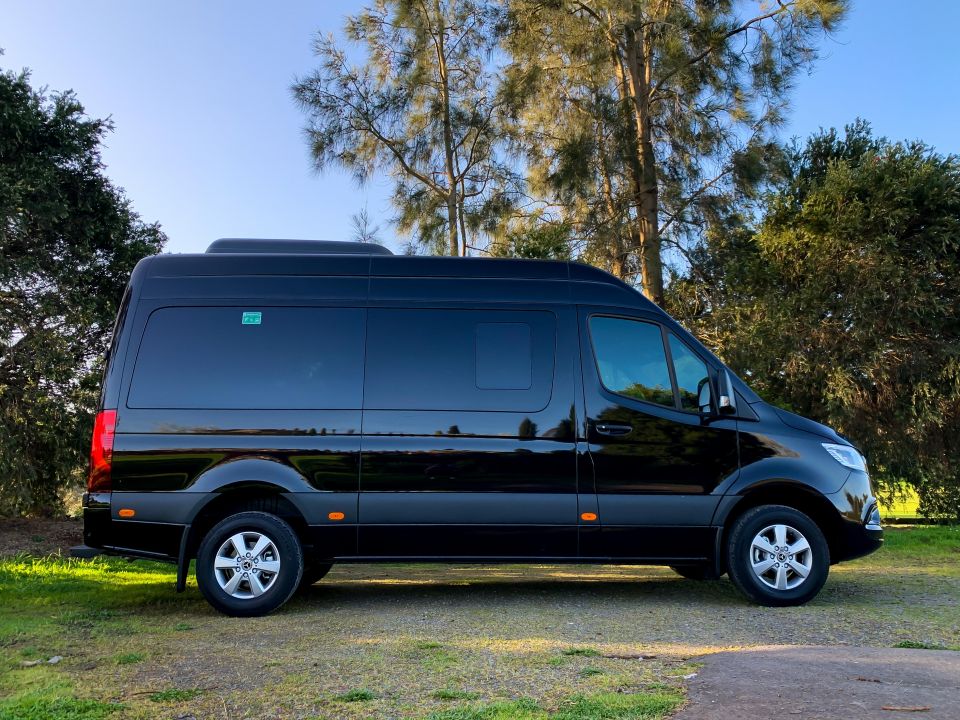

Marketplace Editor
New from
$49,720
excl. on-roads

Marketplace Editor
New from
$49,720
excl. on-roads


Marketplace Editor
New from
$49,720
excl. on-roads

Marketplace Editor
New from
$49,720
excl. on-roads
Quickly see how this car stacks up against its competition. Select any benchmark to see more details.
Where expert car reviews meet expert car buying – CarExpert gives you trusted advice, personalised service and real savings on your next new car.
The days of commercial vehicles lacking safety and tech are long gone, led by vehicles like the Mercedes-Benz Sprinter pioneering the introduction of features expected of passenger vehicles in van, buses, and trucks.
When it arrived Down Under back in 2018, the Sprinter brought many driver assistance and infotainment features usually reserved for the three-pointed star’s luxury passenger vehicle line-up – including the swish MBUX online infotainment system.

Given the array of requirements from commercial vehicle buyers, the Sprinter is available with a range of drivetrains, body styles, seating layouts, and more. Regardless of how you tailor yours – there’s more than 1700 possible combinations – it offers a range of high-end systems that will ensure you don’t feel like you’re driving some run-down delivery van.
Earlier this year the company introduced the Mercedes-Benz Sprinter Transfer, a 12-seat shuttle bus based on the medium-wheelbase high-roof van designed for scenarios where a humble seven- or nine-seat people mover just isn’t enough.
The German marque says the Sprinter Transfer is perfect for school and aged care duties, as well as crew bus and airport transfer applications. So, does the Sprinter bus live up to Mercedes-Benz’s claims?
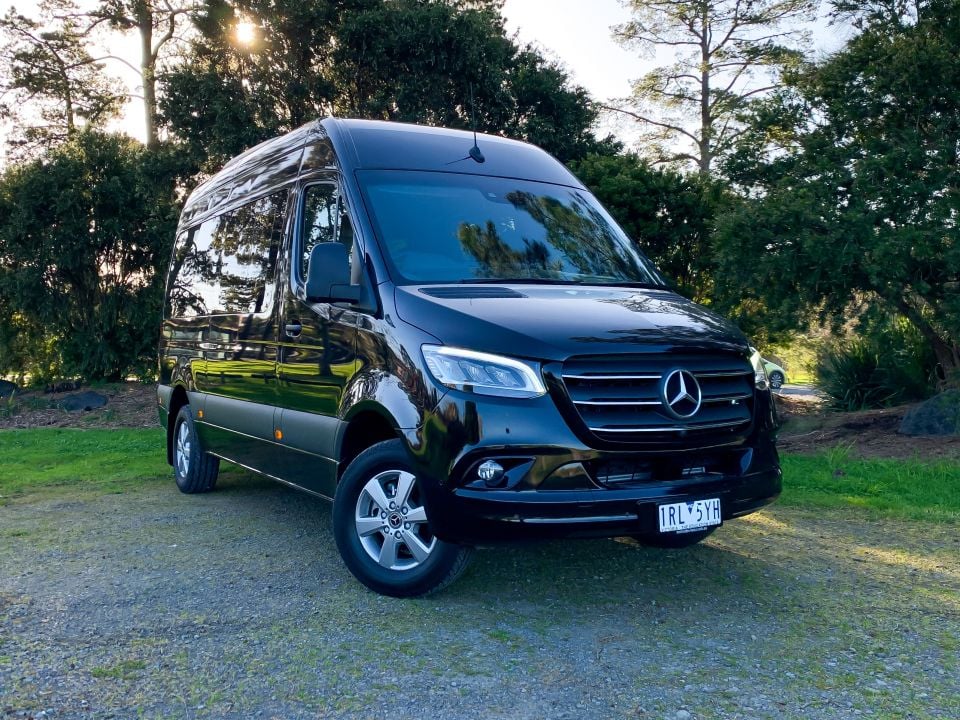
Here on test we have the top-spec Sprinter Transfer 416 MWB, which starts at $87,926 before on-road costs.
There’s also a lower-spec 414 MWB, which gets a less powerful engine and fewer standard features, priced from $72,479 before on-roads.
Our test vehicle also came with over $12,000 of optional features, bringing the as-tested price to $100,269 plus on-roads.
These include an electric park brake ($426), leather-trimmed steering wheel ($253), painted bumpers ($759), adaptive cruise control ($1210), a high-performance roof-mounted rear air-conditioner ($3861), active lane keep assist ($627), and tinted windows ($611).
It also had the Driver Comfort Pack ($2420) – adding 360-degree cameras, front and rear parking sensors, a heated driver’s seat, a suspension seat for the driver, driver’s convenience head restraint, and halogen front fog lights. Our tester’s metallic black paint is a hefty $2200 extra.

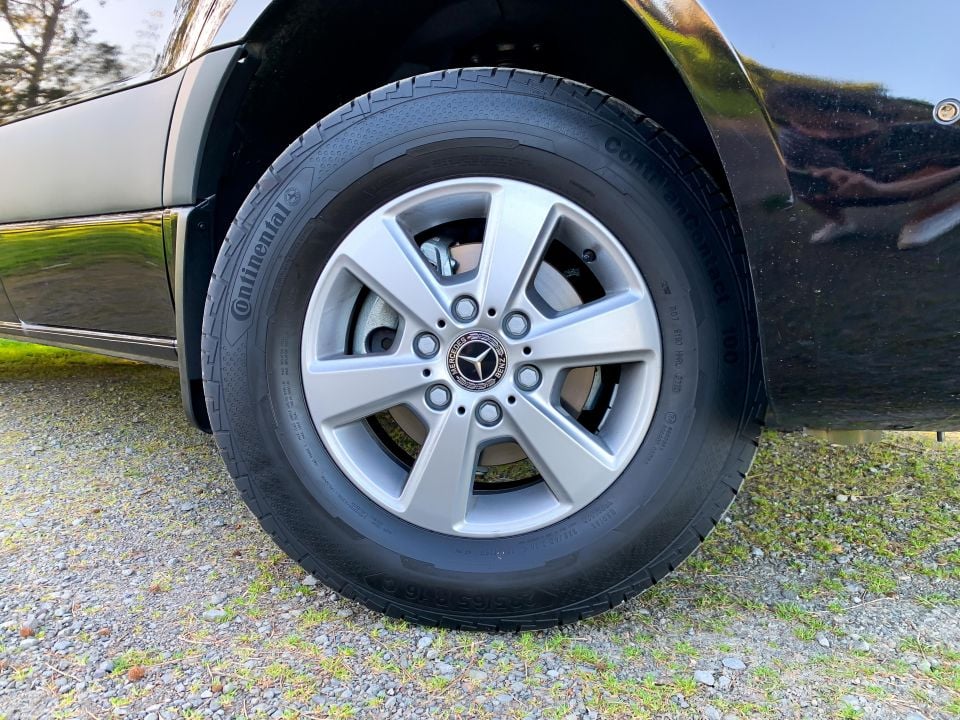

Buy your new car without the stress. It's fast, simple and completely free.

Great service from Travis and team, second time I have used this business would not hesitate to recommend them to anyone
Craig C.
Purchased a Ford Ranger in Sunshine Coast, QLD
CarExpert helped Craig save thousands on his Ford Ranger, now let us save you on your next new car.
Find a dealStandard equipment unique to the Sprinter Transfer 416 includes a chrome grille, auto headlights and wipers, LED headlights with high-beam assist, partial LED tail lights, 16-inch light alloy wheels, an electronically-operated curb-side sliding door, a ‘comfort overhead control panel’, and window pillar panelling.
That builds on the specification of the Sprinter Transfer 414, which already features a 3+2+3+4 seat configuration (12 seats in total), keyless start, a 7.0-inch MBUX infotainment touchscreen with wired Apple CarPlay and Android Auto, semi-automatic air-conditioning with a basic separate rear roof-mounted air-con (no heating function), heat-insulating glass, a colour display in the driver’s instrument cluster, driver’s lumbar support, as well as two-way loudspeakers front and rear.
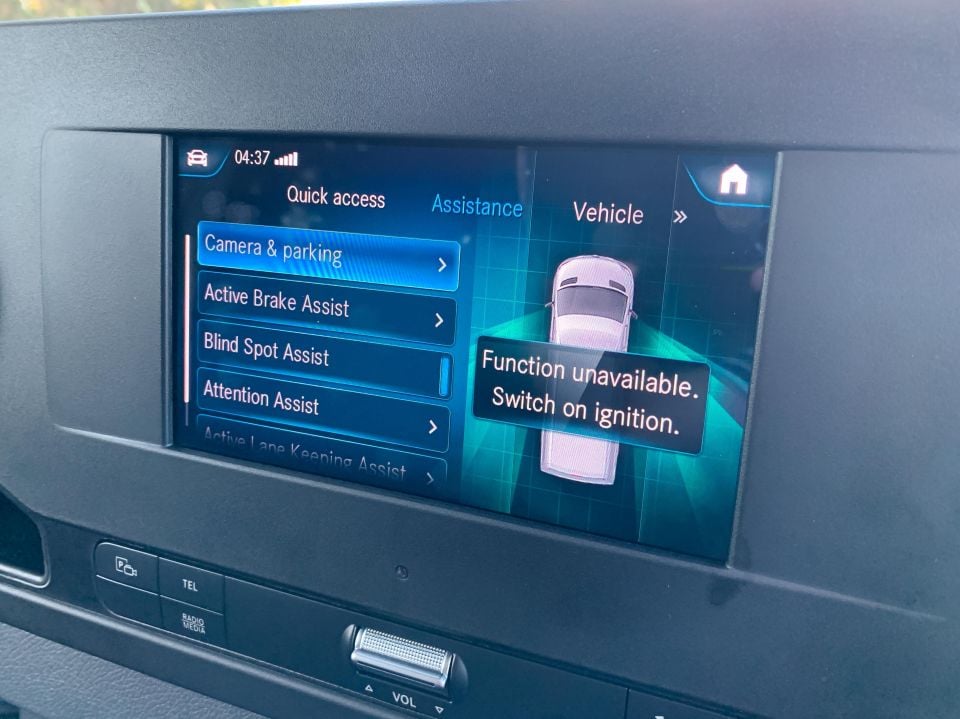
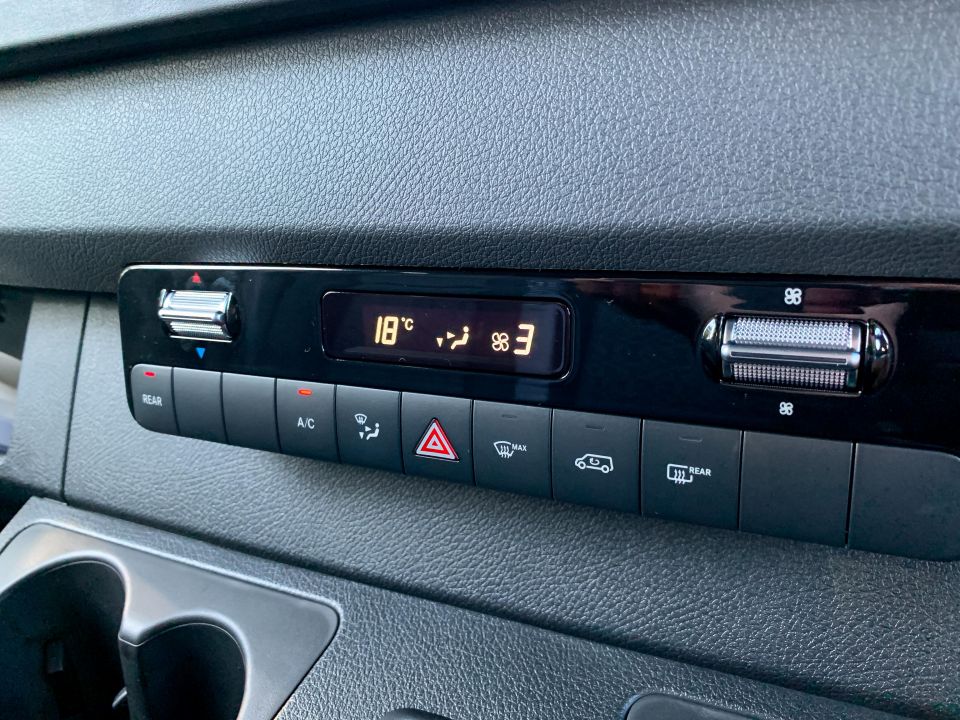
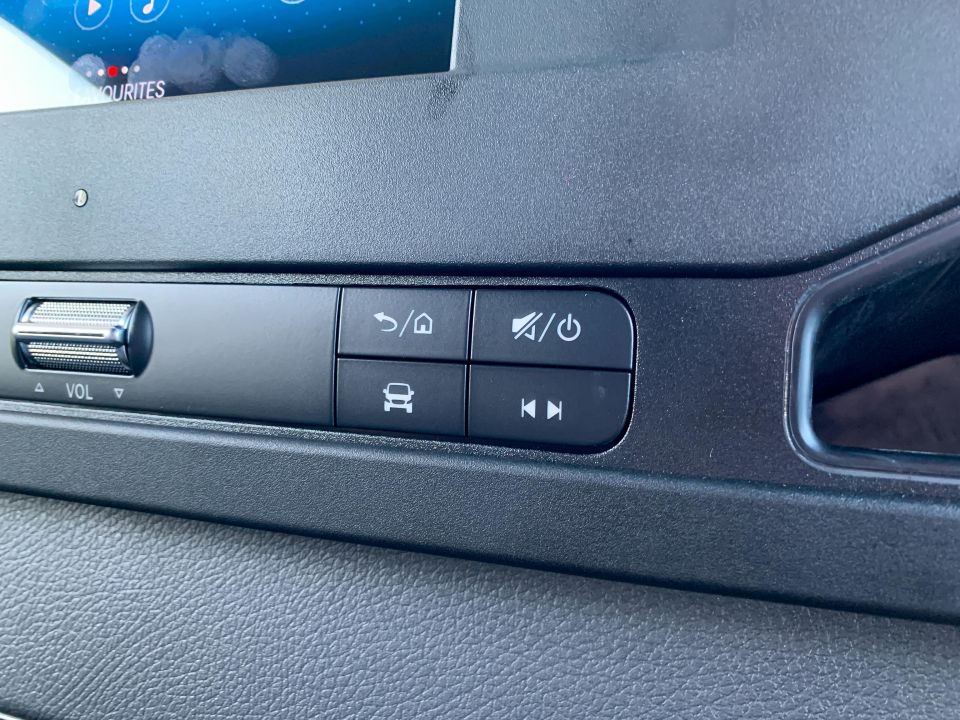
Standard safety equipment includes Active Brake Assist (Mercedes-speak for AEB), blind spot assist, lane keeping assist, driver attention monitoring, a reversing camera, cruise control, and an adaptive ESP system incorporating features like hill-start assist, crosswind assist, brake disc wipers, roll-over mitigation, roll movement mitigation, trailer stabilisation, and Easy Lane Change.
Numerous other items remain on the options list, including electric front seats ($2723), a higher-grade MBUX infotainment system with 10.25-inch touchscreen and inbuilt satellite navigation ($1760), DAB radio ($275), front side thorax airbags ($726), wireless smartphone charging tray ($220), tyre pressure monitoring ($473), traffic sign assist ($418), and comfort air suspension ($4400).
All versions of the Mercedes-Benz Sprinter Transfer offer a max tow rating of 2000kg, a GCM of 5500kg, and a GVM of 4100kg. The 416 offers a payload of 1455kg, which is 10kg less than the 414 likely to offset its heavier tare mass (2594kg) compared to the standard model.
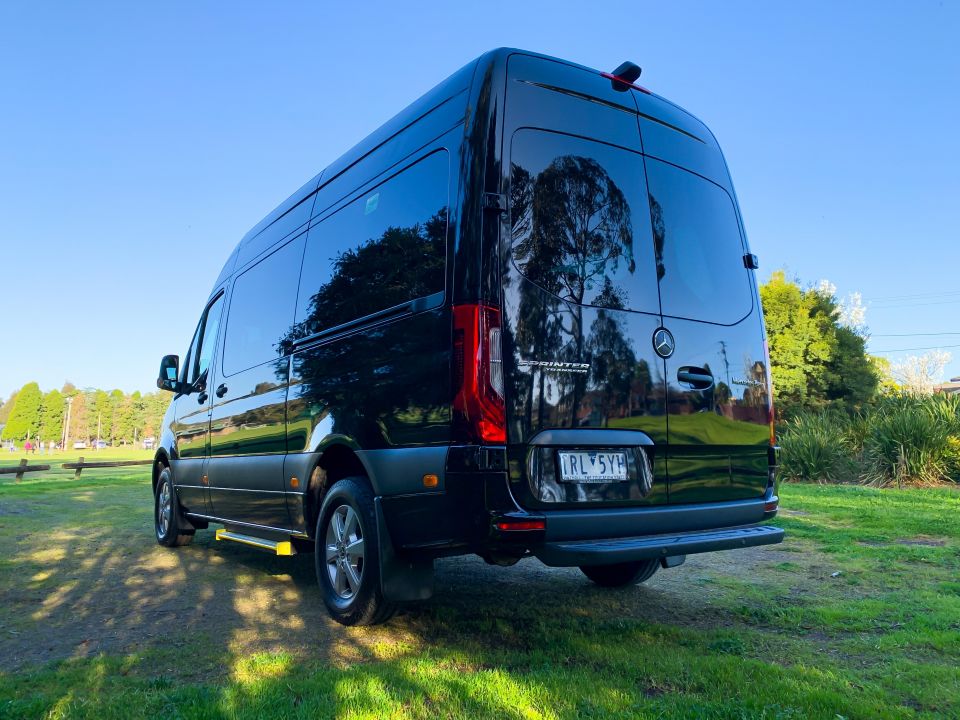
The Sprinter hasn’t been officially crash tested by ANCAP nor its European equivalent.
However, Benz offers a range of standard safety technologies as outlined above, as well as the optional equipment fitted to our test vehicle to help assist the driver in avoiding accidents in the first place.
There’s also airbags for the driver and ‘co-driver’ as Mercedes calls the passenger, with coverage for the front and side windows in the cockpit. An additional thorax airbag is optional for the driver and front passenger, however there’s no airbag coverage for the nine seats in the rear.
Seatbelt warnings for the driver and co-driver further bolster the Sprinter Transfer’s safety specification, as does an electrically-deploying side step for the sliding rear door for easier access into the rear passenger compartment.

Huge. Walking up to the 2578mm-tall bus you’re immediately given the impression the Sprinter Transfer has a lot of space – and it certainly delivers on that first impression.
It’s a big step up into the cockpit area, even for six-foot-one me. There’s a trim at that first step that kept coming loose in our tester, by the way, and would fall out onto the ground whenever we opened the front door – it ended up being relegated to the boot after a few tries at keeping it in place.
Once planted in the optional suspended driver’s seat, there’s great outward visibility and a genuine feeling of airiness and space thanks to the high roofline and plentiful glasshouse. Having big mirrors with blind-spot assist and optional 360-degree cameras gives you added peace of mind, too.
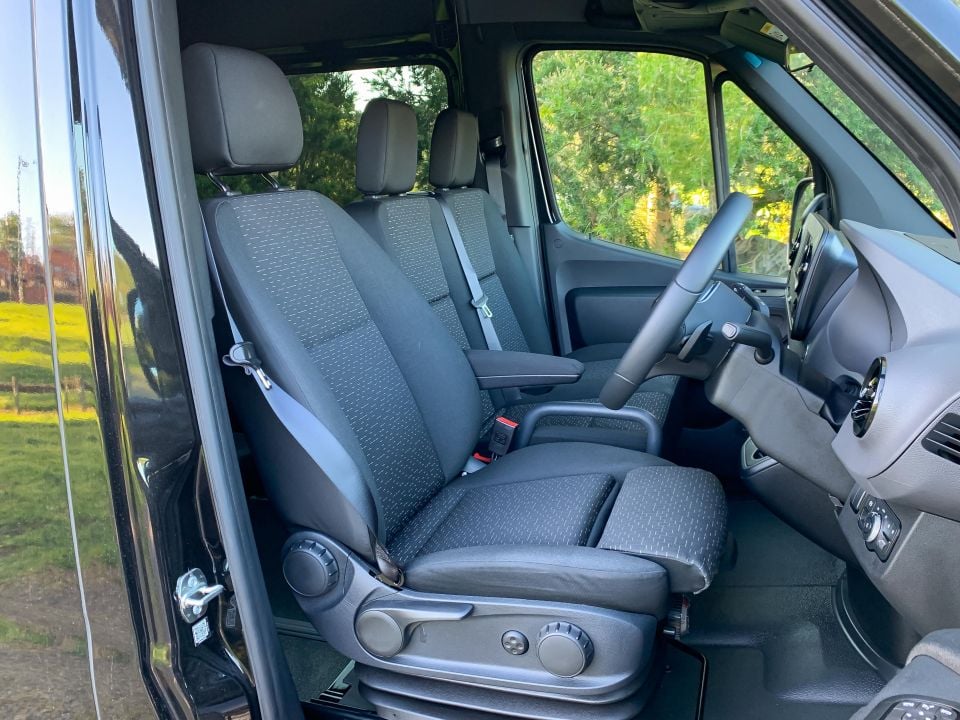
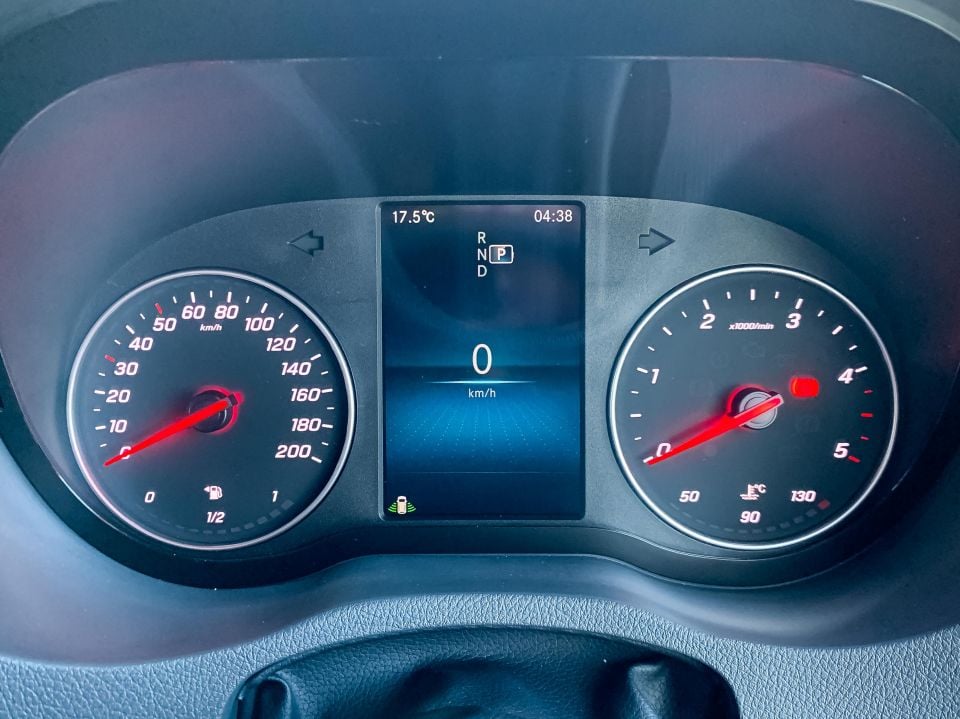
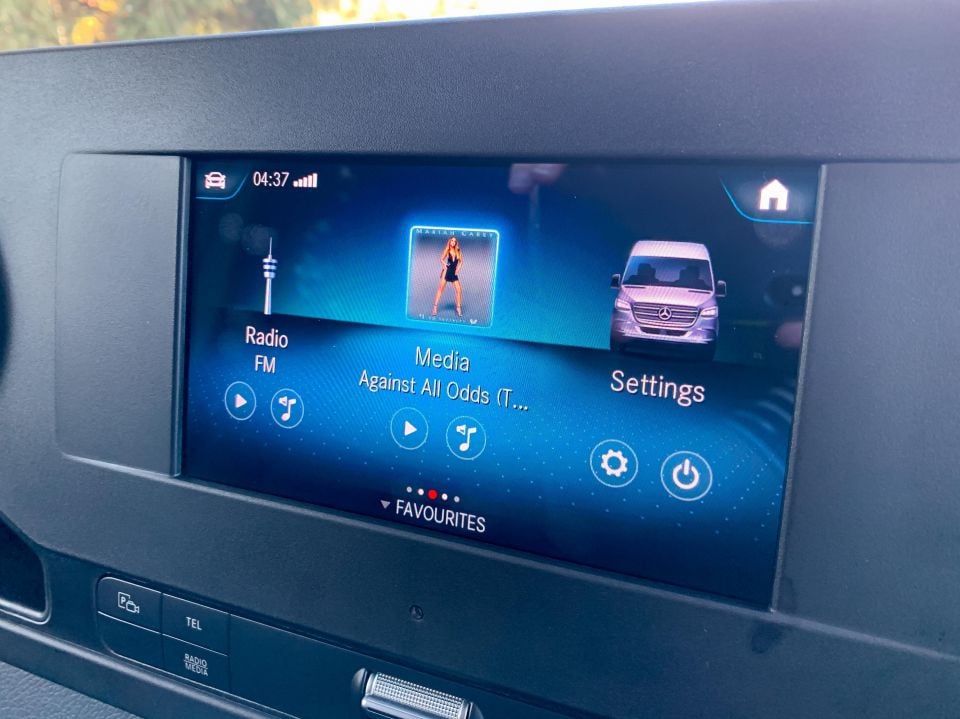
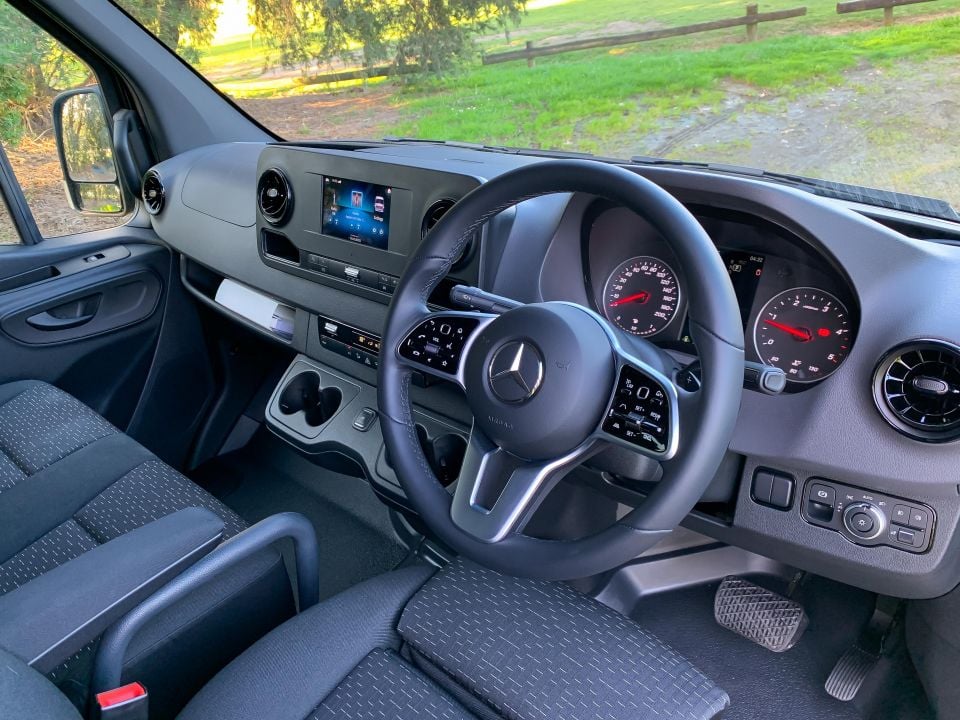
There’s plenty of space for three occupants up front, with good storage options and ergonomically-placed controls on the centre slack. I would say, though, it’s odd the semi-auto air-conditioning has digital temperature controls but a manual fan speed – why not just have climate control?
Being a commercial vehicle, the Sprinter’s cabin errs on the side of durability rather than going overboard with plush upholstery and the soft-touch plastics you’d find in a Benz passenger car. With that said, the cabin feels very well put together and everything you touch feels of a high quality – minus the aforementioned piece of loose trim.
Drivers get plenty of adjustment options, including reach and rake for the steering column, so finding a comfortable driving position isn’t too difficult. The instrument binnacle is wonderfully clear and easy to read, too, thanks to the clean, crisp analogue dials and high-resolution cluster display.
The steering wheel is also straight out of a Mercedes-Benz passenger car, with the optional leather trim feeling good in the hand and all the included switchgear and touch capacitive buttons feeling familiar.
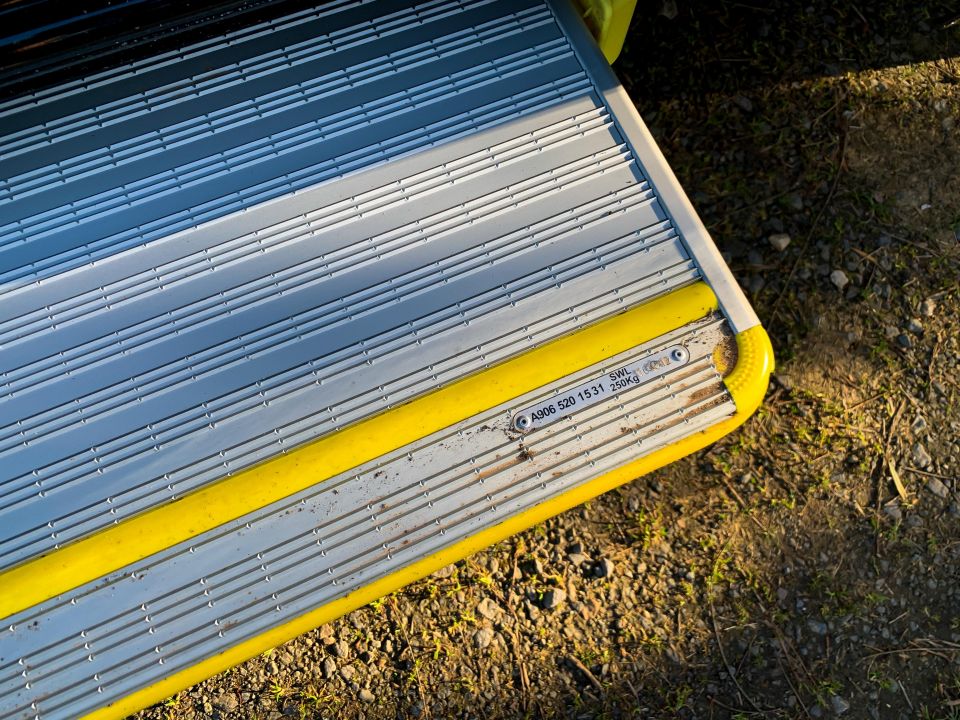
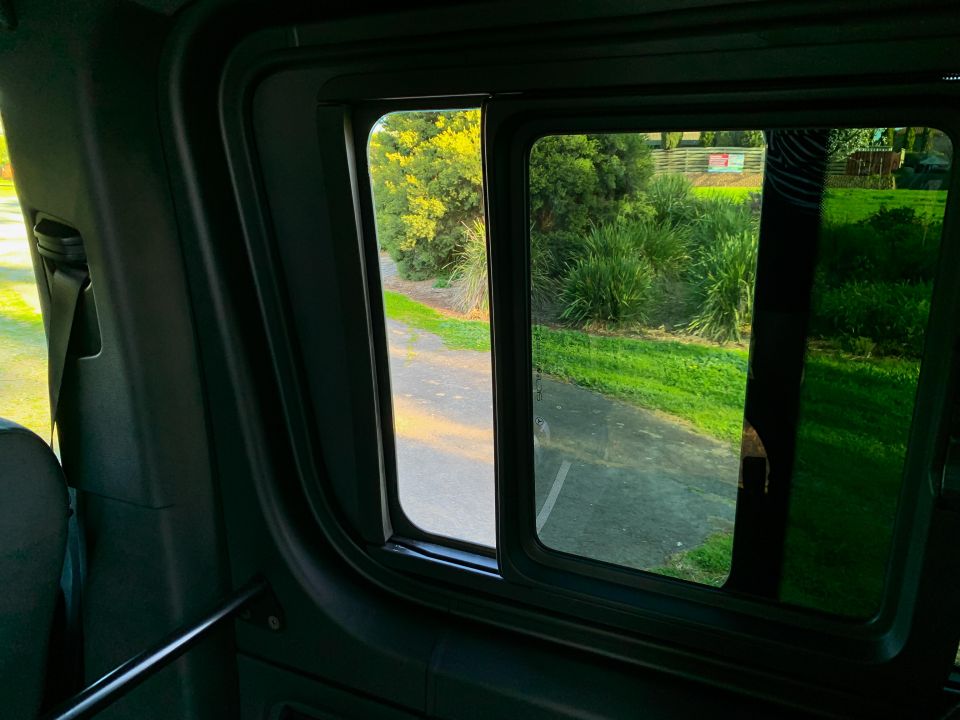
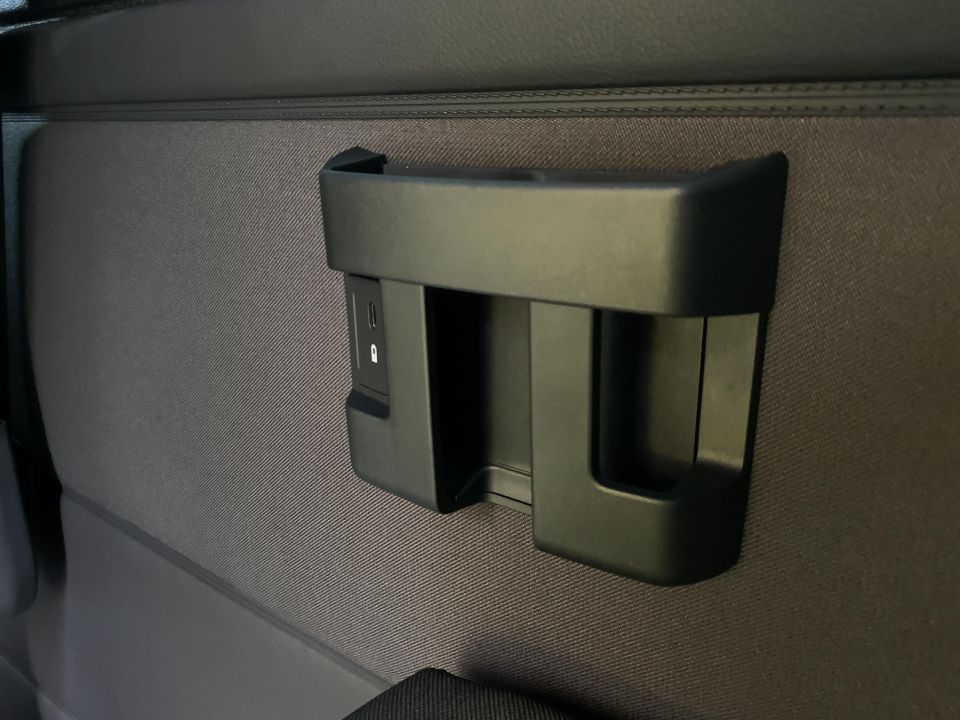
Moving into the rear passenger area, it genuinely feels like a proper bus. I’m a little over six-foot-one and I can stand upright in the back with plenty of room to spare.
Getting in and out is easy thanks to the large auto-sliding side door as well as the auto-deploying side step – which can hold 200kg. There’s also a hand rail on entry for anyone that may need some assistance clambering in, too.
The 2+3+4 seating arrangement in the rear offers plenty of room for an additional nine passengers with room to spare, though whoever occupies the seat behind the railing might a little tighter for space than everyone else. There’s an additional 9.0 cubic metres of cargo volume too, according to Mercedes-Benz.
You’ll find USB-C points and phone holders scattered throughout the seating rows, meaning passengers can charge and store their devices while you’re on the move.
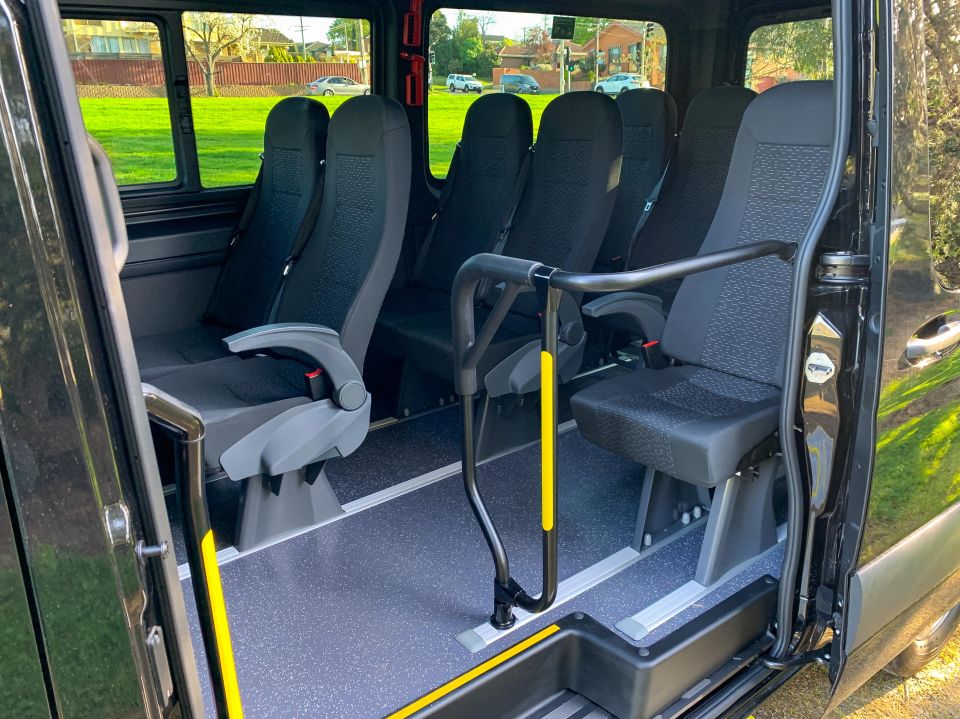
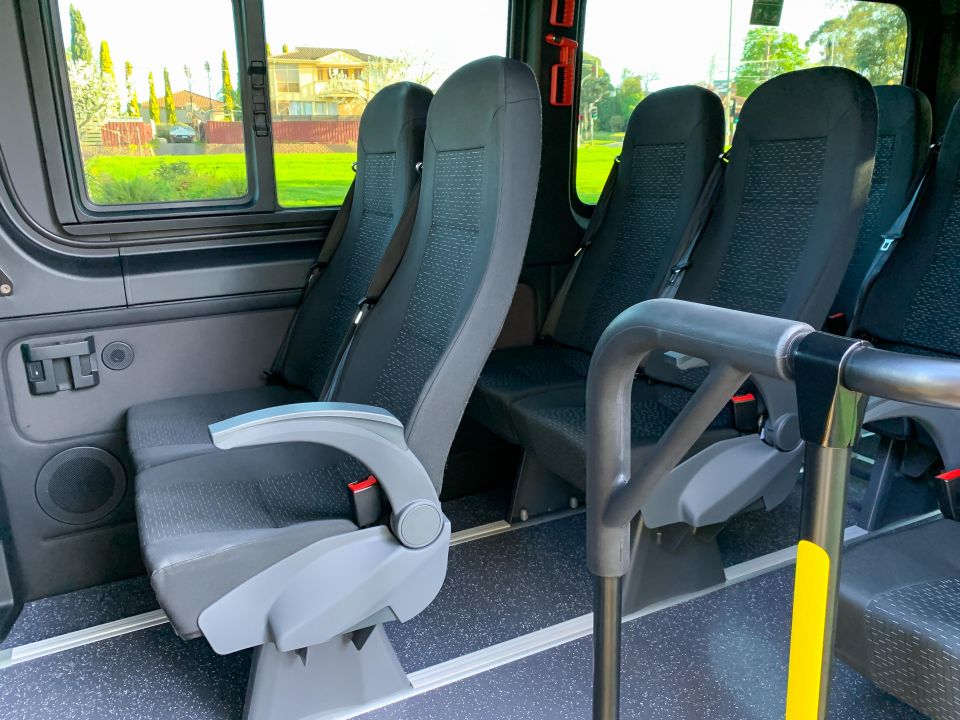
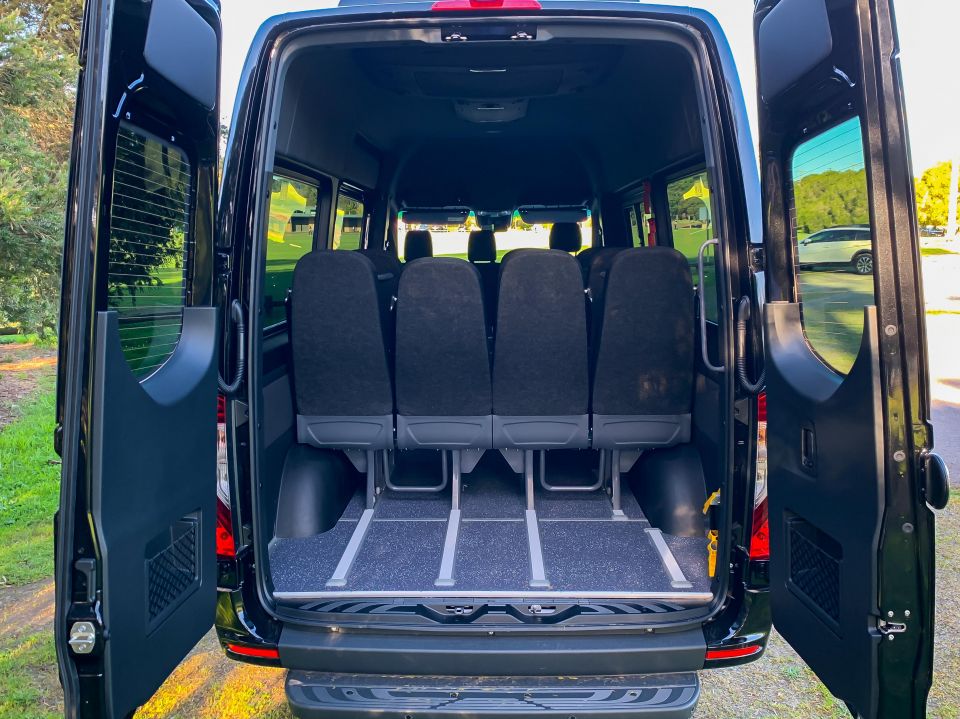
Each of the nine rear seats is large enough for most adults in terms of width and legroom, meaning you can have a bum on each pew without compromising overall passenger comfort – a key differentiator between the Sprinter Transfer and a smaller people mover.
The seats individually recline, with row-mounted seats fitted with adjustable armrests. All seats also get three-point seatbelts, and there’s a sliding window in the second row to let some fresh air in.
At the rear the barn-style doors open in a two-stage process to reveal a flat, tall and wide load area. If you were to take a group of 12 (including the driver) on a winery tour, for example, there’s plenty of room for bags, shopping, and any other luggage.
The roof-mounted air-conditioner (upgraded to an optional high-performance unit in our tester) brings added benefits on hot days with a full cabin, though unfortunately we weren’t able to test its effectiveness with passengers on board thanks to Melbourne’s strict COVID-19 restrictions.
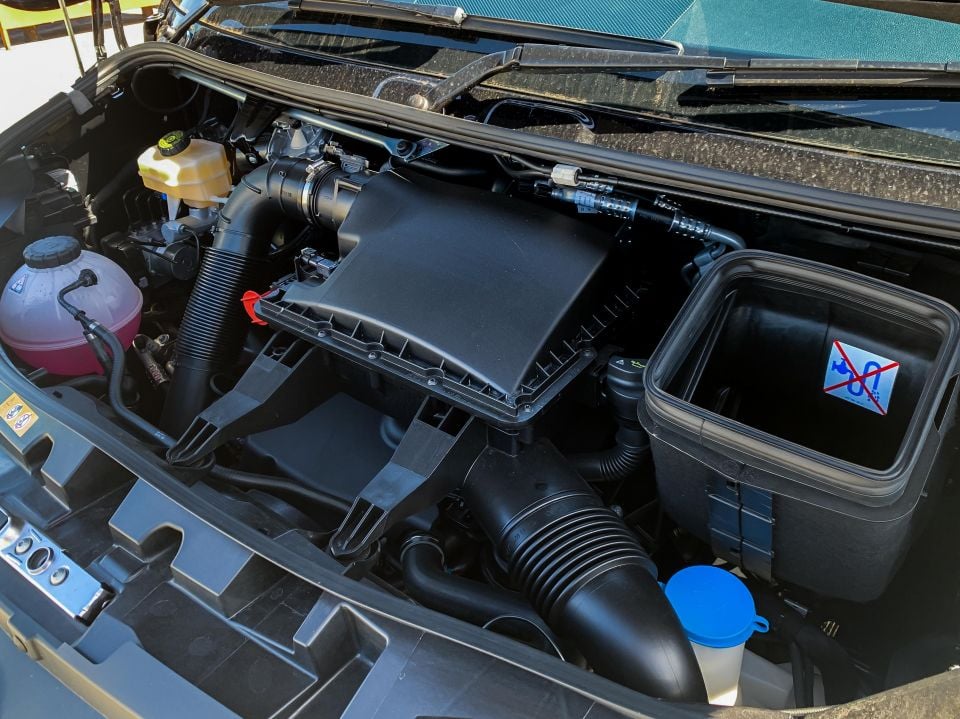
Both versions of the Sprinter Transfer are powered by Mercedes-Benz’s venerable 2.1-litre twin-turbo four-cylinder dieselengine, with the 416 variant getting a more powerful tune.
Outputs for the top-spec model are rated at 120kW (163hp) and 360Nm, up on the 414’s 105kW and 330Nm. Maximum torque is available between 1400 and 2400rpm, while peak power is on tap at 3800rpm.
Drive is sent to the rear wheels via a ‘7G Tronic’ seven-speed automatic transmission, operated via Benz’s typical column-shift setup.
The engine is hooked up to a 71-litre fuel tank, and being Euro 6 certified it also features AdBlue injection for reduced emissions. There’s also idle stop/start technology on-board, too.
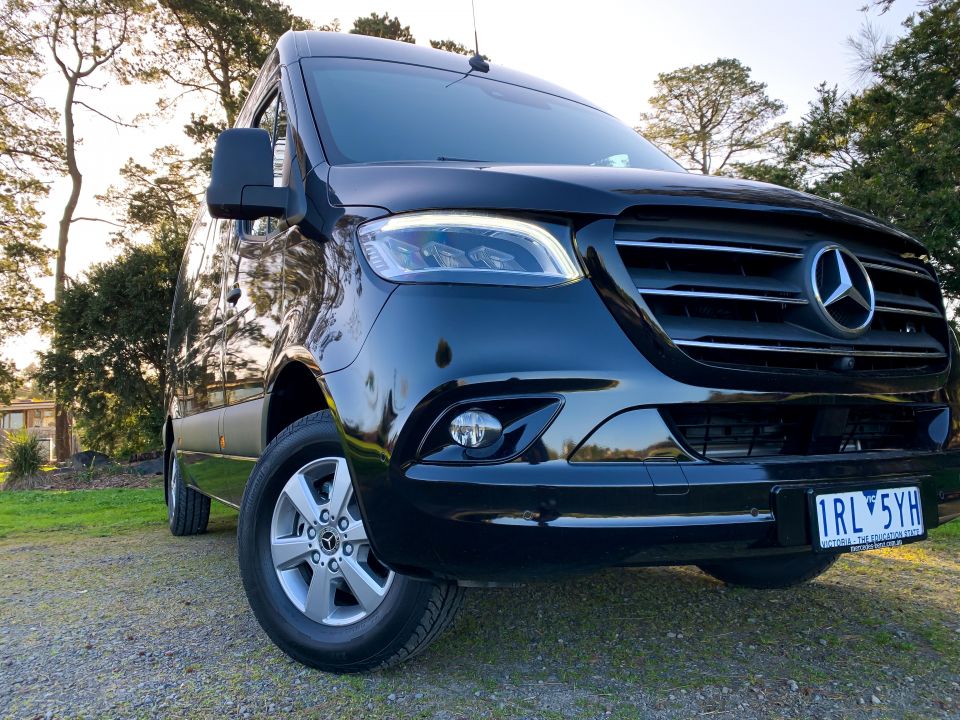
Surprisingly well. I’ll admit I was concerned the Sprinter bus would be a handful to drive, but it turned out to be quite the opposite.
Despite the tall dimensions and overwhelming feeling of length, the Sprinter Transfer is relatively car-like to drive in terms of the responsiveness of the driver controls, and it’s rather manoeuvrable for a 5932mm long bus.
The steering is light and a little numb, but turns and navigating carparks is much less of a chore than you might think. That said, a lot of carparks won’t let you in because the Sprinter Transfer’s roof is just too tall – let alone a McDonald’s drive thru.
Outward visibility is fantastic as mentioned earlier, with great view out of the huge glasshouse and good viewing angle from the split side mirrors with blind-spot monitoring. The optional 360-degree camera system and front/rear parking sensors fitted to our test vehicle were a welcome aid during tighter manoeuvres, and we would strongly suggest ticking the box for these features as they come in handy.
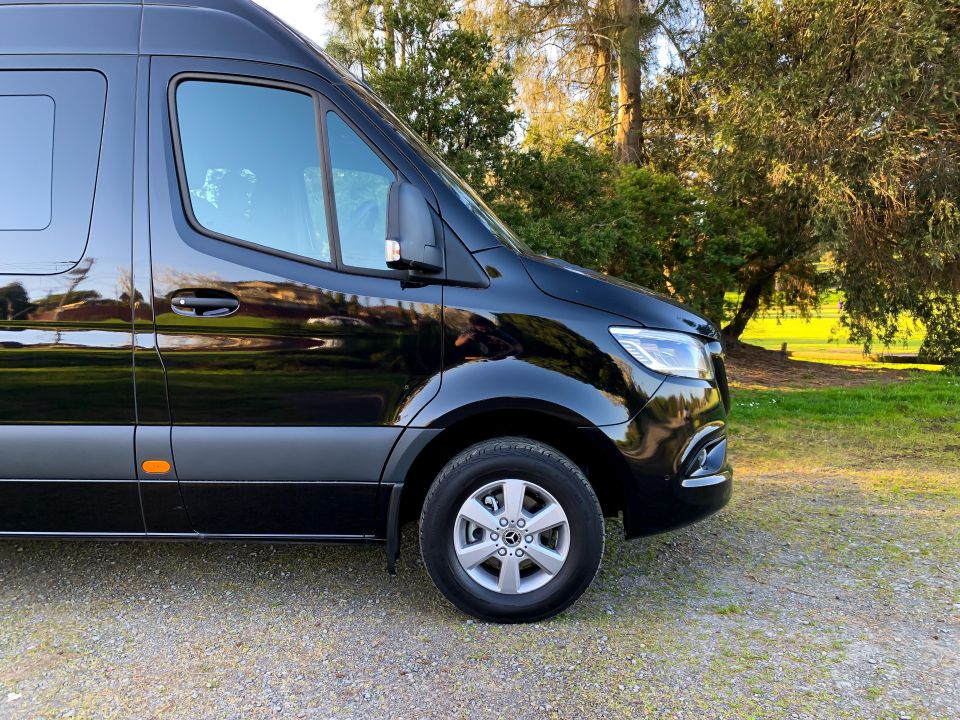
Speaking of the cameras, it was at times difficult to get a good view of the Sprinter’s surroundings on the base 7.0-inch display fitted as standard here. The optional 10.25-inch display – first seen in the current A-Class small car – would be far more appropriate in a vehicle this big.
Three-point turns are surprisingly easy, and usually kept to just three points rather than more, and you don’t have to constantly adjust in tight turns to avoid clipping the rear wheels on kerbs.
Beyond the confines of carparks and airport pick-up/drop-off lanes, the Sprinter Transfer is a competent and comfortable cruiser on the open road, aided by a range of sophisticated driver assist systems to keep you on the straight and narrow (standard and optional).
The high-output tune of the 2.1-litre twin-turbo diesel offers heaps of low-down torque to get the 2.7-tonne (kerb) bus going without much fuss, and the seven-speed automatic shifts swiftly and smoothly so the Sprinter doesn’t feel too jerky and agricultural. We found the idle stop/start system to be one of the better systems of its type despite being a commercial vehicle, acting quickly and never feeling intrusive.
With that in mind, though, we didn’t get a chance to fully load up the Sprinter Transfer with people and luggage to test out the engine while laden. Performance should still be adequate, but it certainly wouldn’t be considered ‘brisk’.
At freeway speeds the Sprinter settles quietly into its seventh ratio and the diesel engine hums away in the background. Road and wind noise is kept at relatively low levels and the tall body feels nicely planted at Australia’s 100-110km/h speed limits.
Given these need to be able to cruise at much higher speeds on the German autobahn, the Sprinter’s planted open-road manners inspire plenty of confidence despite its tall and boxy dimensions, along with the teeny-tiny 16-inch wheels and 235/65 rubber.
The ride certainly settles on the open road but is on the firmer side around town, exhibiting a bit of jitteriness when unladen over smaller imperfections around town. Air suspension is optional, but the conventionally-sprung standard setup does the job and would likely feel better with people in the back.
We found the optional adaptive cruise control and upgraded lane keep assist systems to be very helpful in such a large vehicle. Given it’s meant to be designed to carry a lot of passengers also carries with it serious responsibilities, anything to help the driver should be welcomed.
In fact, we’d argue most of these features should be standard rather than optional. Ford, for example, offers most of these features as standard on the Transit Bus – due to land in Australia in November 2020 – demonstrating commercial segments are quickly moving forward in terms of safety tech.
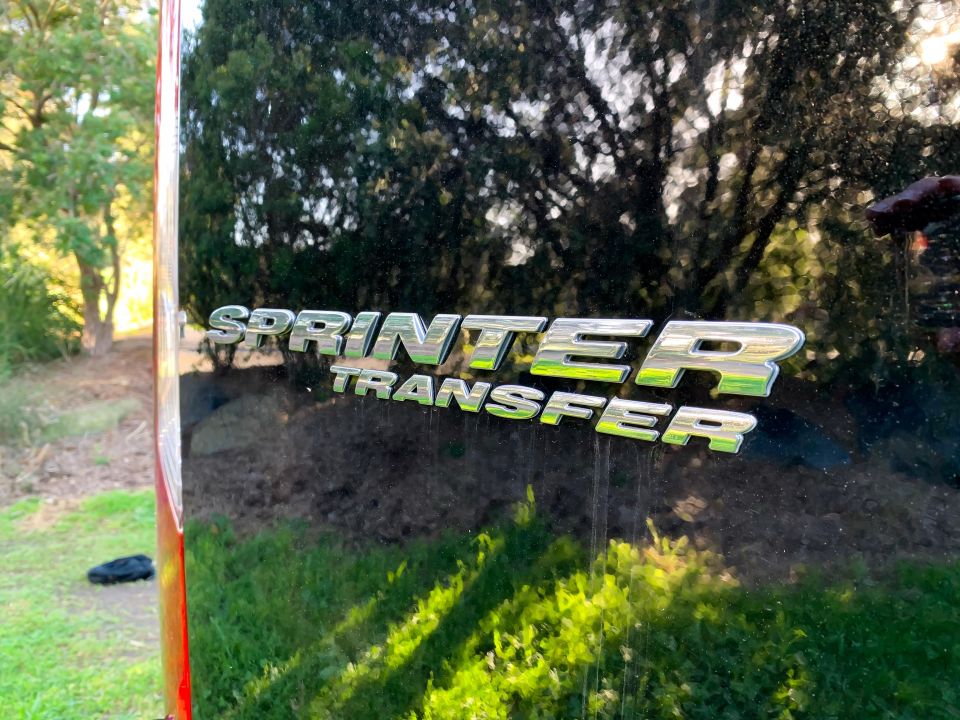
Where expert car reviews meet expert car buying – CarExpert gives you trusted advice, personalised service and real savings on your next new car.
Mercedes-Benz Vans covers the Sprinter range with a five-year, 250,000 kilometre warranty, with 24/7 roadside assistance included for the same period.
In an effort to minimise maintenance visits and costs, Mercedes-Benz offers two-year/40,000km intervals between services. Pre-paid ‘BestBasic’ service plans are available, covering up to five years of maintenance.
Should you prepay for the plans, it’ll cost $2278 for three years, $3135 for four and $3936 for five. Compared to the pay-as-you-go pricing, you’ll save $402 over three years, $665 over four and $984 over five.
Mercedes-Benz doesn’t quote an official combined fuel consumption figure. We achieved an indicated 10.0L/100km over a mix of freeway and urban driving, though it was entirely spent unladen.
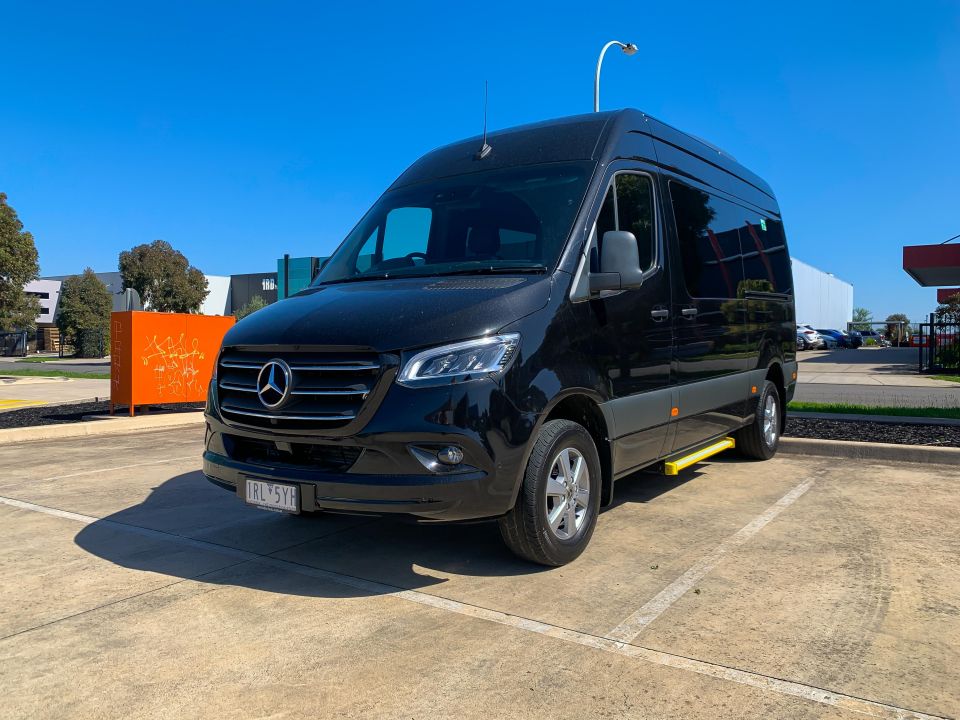
As is the case with most niche commercial vehicles, the Sprinter Transfer is a specific answer to a specific question, and likely isn’t a viable option for private buyers looking for an alternative to a regular people mover.
Instead, the Sprinter Transfer offers a comfortable, high-tech, and hugely practical solution for individuals and businesses that require a purpose-built people carrier that doesn’t skimp (much) on features or refinement.
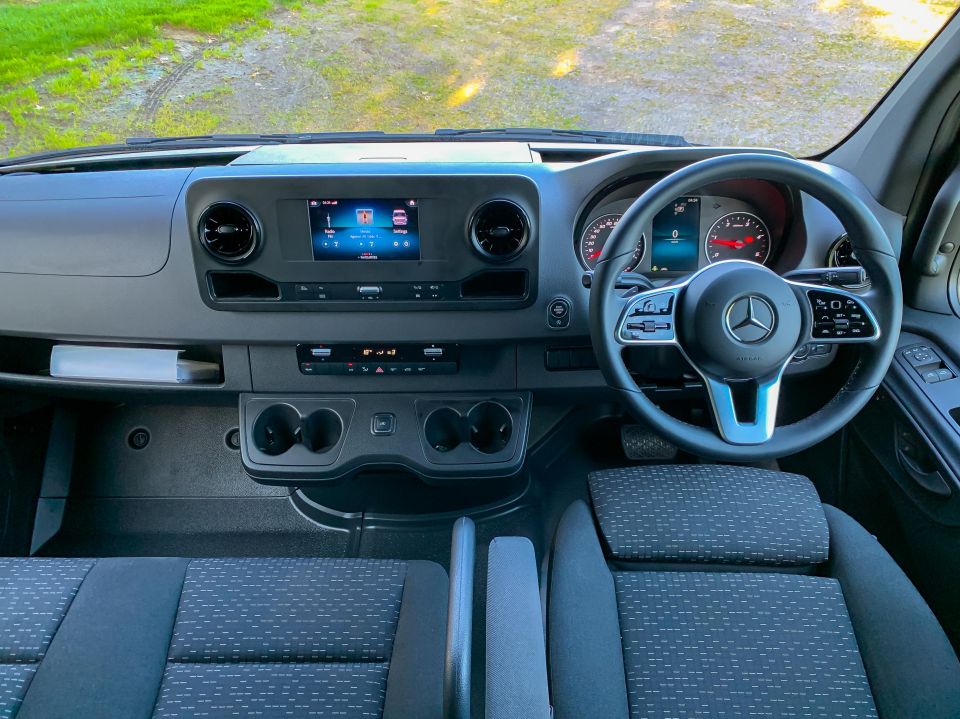
That doesn’t come without its compromises, of course. The Sprinter Transfer can get very expensive once you start adding options – easily north of $100,000 – and some of those optional features should just be standard in the first place.
Furthermore, its sheer size may prove too daunting for some, and it’s a shame a minibus designed to carry 12 people and their belongings isn’t available with the punchier 140kW/440Nm 3.0-litre V6 turbo-diesel available elsewhere in the vast Sprinter portfolio.
That said, the Sprinter bus is certainly befitting of the big three-pointed star on its nose, and if your requirements match up with the Transfer’s capabilities, you’ll no doubt be satisfied with the Benz bus.
Where expert car reviews meet expert car buying – CarExpert gives you trusted advice, personalised service and real savings on your next new car.
James Wong is an automotive journalist and former PR consultant, recognised among Australia’s most prolific motoring writers.


Matt Robinson
40 Minutes Ago


Damion Smy
40 Minutes Ago


Damion Smy
15 Hours Ago


Damion Smy
16 Hours Ago


Damion Smy
18 Hours Ago


Damion Smy
19 Hours Ago